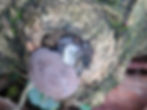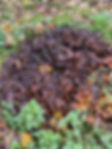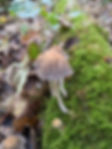Fungi in Stanmer Great Wood. 28.10.22
- Sim Elliott
- Oct 31, 2022
- 4 min read
Stanmer Great Wood is on the north-east of Brighton. It can be reached very easily by the 25 bus which is very frequent.; see: 25 - Universities-Old Steine | Brighton & Hove Buses
The identifications I have made of these fungi may be wrong! I am very new to fungi identification. I have used Buczacki, Shields & Ovenden (2012) Collins Fungi Guide Collins Fungi Guide : The Most Complete Field Guide to the Mushrooms & Toadstools of Britain & Ireland: Stefan Buczacki: 9780007466481: hive.co.uk. This post is a work in progress: some of the fungi identifications are very tentative; I will update this post as I learn more!
Stanmer's Great Wood was planted in the 18th and 19th century ... There's an avenue of veteran Beech trees planted 300 years ago lining a track once used as an original carriage drive through Stanmer Great Wood. And there are many champion trees which, because of their height and/or girth, are listed in a national database of the most notable trees in the UK. ... Over the years, Stanmer Park has undergone huge changes. The 1987 Great Storm caused extensive damage especially among the Beech trees. Sadly, in recent times hundreds of Ash trees have died and been felled for safety after becoming infected with the Ash dieback fungus. Elms too have been ravaged by Dutch elm disease. Special trees of Stanmer Park (brighton-hove.gov.uk)

Most of these photos were taken in the south part of the Great Wood, between the south and Stanmer House
Probably Turkeytail, Trametes versicolor


A huge Birch polypore, Piptoporus betulinus It looks nothing like the illustration in the Collins Fungi Guide, and the description from the Wildlife Trust The birch polypore is a fleshy fungus that is round or hoof-shaped, with a rounded edge and leathery look. It is a milky coffee-colour on top, and has white pores underneath. It has a strong, fungusy smell.
What is so tricky about fungi identification is that individual fungi species come in a whole range of morphological and colour variations. I only know this is a Birch Polypore, as I checked the ID in the British Mycological Society Facebook Group - jolly good group. British Mycological Society (BMS) | Facebook
It can be seen all year-round. Fungi belong to their own kingdom and get their nutrients and energy from organic matter, rather than photosynthesis like plants. It is often just the fruiting bodies, or 'mushrooms', that are visible to us, arising from an unseen network of tiny filaments called 'hyphae'. These fruiting bodies produce spores for reproduction, although fungi can also reproduce asexually by fragmentation. Birch polypore | The Wildlife Trusts



The fabulously named King Alfred’s cakes, Daldinia concentrica, aka Cramp Balls! Tiny fire-lighters with an embarrassing story, King Alfred’s cakes are named after the king’s poor baking skills. Spot them growing in broadleaf woodland where they can last for years. King Alfred’s Cakes (Daldinia concentrica) - Woodland Trust
Flora, fauna and funga, are very interconnected: "The larvae of the micro moth Harpella forficella feed on decaying wood, under bark of various deciduous trees and also on some fungi, including Daldinia concentrica. The moth was first seen in Britain in 2011, in Berkshire, and has since been seen in Sussex and Leicestershire. Although small, the moth is very pretty, and worth looking out for. King Alfred's Cakes, Daldinia concentrica | Jeremy Bartlett's LET IT GROW blog


Rotting wood.

Candlestick Snuff, Candlesnuff Fungus (Xylaria hypoxylon): I originally thought these were Dead Man’s Fingers (Xylaria polymorpha); but I got help from the British Mycological Society's Face Book Group!


Both the “dead finger” species are bigger than the Candlesnuff, with projections of about 3-5cm long. In the case of Dead Man’s Fingers, often forming tufts of fingers giving the appearance of a charred, arthritic hand reaching out from a log.
Like the Candlesnuff, they feed not on the cellulose or lignin, which make up the hard substance of wood, but on the polysaccharide binding substances which glue the cellulose and lignin together. Once all the polysaccharides have been digested, all that is left is a pile of soft wood fragments which can be eaten by insects, or further digested by other fungi. Dead Man's Fingers and late Ladybirds - Horniman Museum and Gardens


Decaying fungi; not sure which species



Orange (top-left): probably, Velvet Shank, Flammulina velutipes.The lovely orange-brown caps of Flammulina velutipes continue fruiting through the winter. Commonly known as Velvet Shank, this is a stump-rotting fungus; it also occurs on standing dead wood. Flammulina velutipes, Velvet Shank mushroom (first-nature.com)
Centre: probably, a Hiney Fungus, Armillaria sp



Probably Fairy Inkap Coprinellus disseminatus, Fairy Inkcap rarely ventures forth alone or even with just a few friends; more often it forms dense masses swarming over rotting tree stumps and roots.These gregarious little fungi occur from early spring until the onset of winter, and they are at their most spectacular when the caps are young and pale - sometimes nearly pure white. It takes just two or three days for young white caps to turn grey and then begin blackening. Coprinellus disseminatus, Fairy Inkcap mushroom (first-nature.com)

More Candlesnuff Fungus


Rusty Dot Pearl Moth, Udea ferrugalis. A migrant species that can sometimes arrive in large influxes with other migrants. The Rusty Dot Pearl has multiple generations each year, usually spending winter as a pupa in the soil. Rusty Dot Pearl | Butterfly Conservation (butterfly-conservation.org)



More Fairy Inkap Coprinellus disseminatus, think!



Probably, Trooping Funnel, Citocybe geotropa. On soil or among grass in fields or wooded glades, most commonly with oak or beech. Solitary or in small or large trooping groups, sometimes in rings. Buczacki, Shields & Ovenden (2012) Collins Fungi Guide, p. 166






More Fairy Inkcaps, I think



More Turkeytail I think.




Black Cat and Yew Taxus baccata. Classified as an ‘ancient tree’. Believed to be the oldest tree in Brighton. Girth 5.94m. Stanmer churchyard. The yews here were first noted in 1833 in An Historical and Descriptive Account of the Coast of Sussex: Brighton Special Trees of Stanmer Park - A2_Fiona Le Garsmeur 1.pdf (brighton-hove.gov.uk)

Horse Chestnut

Woods on Richmond Hill
Decaying fungi; not sure which species



Possibly Splitgill, Schuzophyllum commune; typically found on beech. Buczacki, Shields & Ovenden (2012) Collins Fungi Guide p. 476





